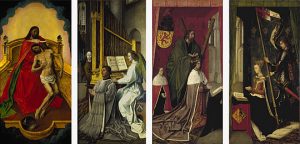Supporting research investigating links between Scotland and the Burgundian Netherlands
Cultural and Diplomatic Relations between Scotland and the Burgundian Low Countries, c.1384-1477
A great enemy and an Aulde Alliance dominate ideas of Scottish foreign policy in the middle ages. From the late thirteenth century to the Union of the Crowns in 1603, Scotland’s international relations often seem rather two dimensional, driven by animosity toward England and, as a result, a shifting alliance with France. My work does not seek to negate the importance of these two factors, rather to look more closely at connections between Scotland and the Burgundian Low Countries from c.1384-1477.

The Trinity Altarpiece – By Hugo van der Goes – http://www.nationalgalleries.org/index.php/collection/online_az/4:322/results/0/17481/], Public Domain, https://commons.wikimedia.org/w/index.php?curid=6776126
Cultural influences from Flanders to Scotland can be seen in visual culture, perhaps most strikingly the Trinity Altar Panel. This image of James III, his wife Margaret of Norway, and his son, future James IV, was commissioned from one of the most famous artists of the Low Countries, Hugo van der Goes (d.1482). Trade connections were just as important, with Scottish wool traded in Bruges from at least the mid-thirteenth century and the Ledger of Andrew Halyburton ‘conservator of the privileges of the Scotch Nation’ providing incredible detail on commercial dealings of Scots in Bruges in the years around 1500.
I spent two weeks working through letters, accounts books, diplomatic records, and manuscripts in both the National Library of Scotland and the National Archives to look at the political and diplomatic links between Scotland and the Burgundian Netherlands. I began with the most famous connection, the marriage between James II of Scotland, and Mary of Guelders, daughter of the duke of Guelders and niece of Philip the Good, duke of Burgundy. Mary, like many Scottish queens, has received little attention in her own right, yet she was a fascinating character. Educated at the court of her uncle, and under the influence of her aunt, Isabel of Portugal, third wife of Philip the Good, Mary brought much Burgundian culture to her new kingdom. She has been credited with the promotion of the new order of Observant Franciscans in Scotland, as well as the creation of Trinity College Kirk in Edinburgh, and the rebuilding of Falkland Palace in Fife. She was married in 1449, with the elaborate marriage contact creating ‘federation and friendship’ between France, Scotland, and Burgundy surviving in the National Archives (State Papers, 7/14). Just eleven years later was left as regent for her eight-year old son, James III. Her importance in the months following her husband’s death was recognised by Philip the Good, who sent Lodewijk van Gruuthuse, a rising star at the Burgundian court, and Jehan Hal(l)ewijn to Scotland. The two men obtained free passage from Henry VI through England to reach Scotland, suggesting their mission related to which side Mary should support in the Wars of the Roses. (National Archives, RH 2/2/13/57).
While a great deal more could be said about the political agency of fifteenth-century queens, I wanted to look also at the personal aspects of international relations. Drawing on Huffman’s 2009 study of Anglo-German diplomacy, focusing on ‘social dynamics of political communities’, I wanted to explore the personal dimensions of political life. This began with famous family connections, on the Burgundian side the Lalaing family, and on the Scottish side the Douglases. A tournament in 1449 at Stirling between James Douglas and Jacques de Lalaing, connected to marriage negotiations for James II and Mary, was the one of most spectacular examples of interpersonal and familial connections being brought to bear on diplomacy. The Douglas family had long built connections to Burgundy, best shown by an alliance sealed between Archibald 4th Earl Douglas and John the Fearless, Duke of Burgundy, in 1412.
One of the most interesting details to emerge from my time in Edinburgh was the importance of rather less famous figures, for instance the Napier family. The Napiers of Merchiston (ancestors of the famous sixteenth-century mathematician John Napier) rose in service of the Stewart kings, but they were also active diplomats, perhaps even spies. Alexander Napier was sent by James III to the court of Charles the Bold, duke of Burgundy in the 1470s to ‘renew the old confederation’ between Burgundy and Scotland (National library of Scotland, Adv. Ms. .1.19, ff. 98-105). His relative, John Napier, was meanwhile receiving a pension from the English kings (National Library, Charters, A.12), hinting at the complex diplomatic webs around these rising mercantile families.
My original intention was to write up the results of this work as an article, with reference also to the marriages of James II’s sisters to royal courts across Europe and to Burgundian nobility. The records proved far richer than expected, with the importance of female influence emerging in letters and material remains. It is likely that this project will be split between two larger pieces, looking respectively at prosopography and networks analysis in Burgundian-British diplomatic circles and the cultural interactions between Burgundy and Scotland in the fifteenth century.
Dr Laura Crombie
Help us: champion research; stimulate discussion; enhance public understanding; and share our extraordinary heritage. Donate directly to the Society now.